Publications
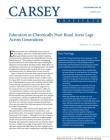
March 29, 2011
As part of the Community and Environment in Rural America (CERA) initiative, the Carsey Institute has been investigating broad trends between rural community types, including the education level of residents and their parents. Since 2007, Carsey researchers have conducted over 17,000 telephone surveys with randomly selected adult Americans from twelve diverse rural locations to ask about both…
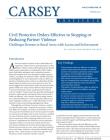
March 9, 2011
Civil protective orders are a low cost, effective solution in either stopping or significantly reducing partner violence for women. While all women benefit from civil protective orders, this brief finds there are greater obstacles to enforcement in rural places, which result in less benefit for rural than urban women. The authors suggest that policies and services should be tailored to address…
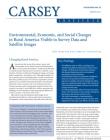
March 1, 2011
This brief focuses on the changing landscapes of different types of rural America where social, economic, and ecological changes are occurring over large areas: the Northern Forest, Central Appalachia, and the Pacific Northwest. These three study sites embody varying historical reliance on land and natural resources and represent very different socioeconomic dynamics. Their common and unique…
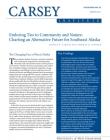
February 15, 2011
Like much of rural America, Southeast Alaska is confronting the social implications of both population declines and the downturn in natural resource-based industries. Although many residents have chosen to leave Alaska in the last decade, the majority have stayed. Strong social cohesion and intimate ties to the natural amenities of the region are what sustain rural Alaskans. It is these…
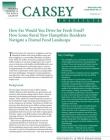
February 8, 2011
Lack of access to food stores with healthy and affordable food is one of the central obstacles to eradicating hunger in America. Approximately 23.5 million Americans live more than a mile from a supermarket, which makes accessing healthy food more challenging. Among low income populations, especially those with young children and limited transportation, this distance can severely limit access to…
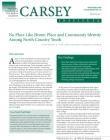
January 19, 2011
This brief explores the link between rural youths’ identification with their community, their self-esteem, and their future plans. The panel study of New Hampshire’s Coos County youth offers a snapshot into the dynamics of a population that is developing its identity in a region that is undergoing an identity transformation of its own. Place identity may be influential in how individuals think of…
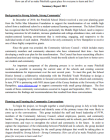
January 15, 2011
In December of 2010, the Pittsfield School District received a one-year planning grant from the Nellie Mae Education Foundation to support the transformation of our middle high school from a traditional school to a student-centered learning environment. The School District has recognized that the Pittsfield Schools, particularly the Middle High School, need to improve
learning outcomes for all…
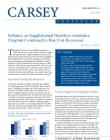
December 14, 2010
The Supplemental Nutrition Assistance Program (SNAP) is one of the most responsive federal programs to economic downturns, as evidence by the increases in SNAP use between 2007 and 2009. Nationally, more than one in ten households relies on SNAP benefits, and the rate is even higher in rural areas, with more than 13 percent of households reporting use. This brief examines the trends in SNAP use…
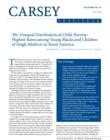
November 29, 2010
Poverty is only one of many challenges tied to a report of child neglect. The analysis in this brief finds that neglected children whose caregivers struggle with substance abuse and mental health problems are at significant risk for out-of-home placement. Risk factors for out-of-home placement for neglected children are discussed, as well as a multifaceted approach to services to prevent neglect…
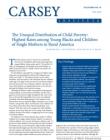
October 25, 2010
Measuring by race, place, and family, this brief highlights poverty rates for two rural groups--young black children and children of single mothers--who each face rates around 50%.

October 13, 2010
Can Community Development Financial Institutions (CDFIs) get unlimited amounts of low cost, unsecured, short- and long-term funding from the capital markets based on their organizational credit risk? Can they get pricing, flexibility, and procedural parity with for-profit corporations of equivalent credit risk?
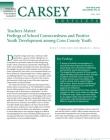
October 11, 2010
Students who feel positively about their education, have a sense of belonging in school, and maintain good relationships with students and staff generally feel connected to their schools. In fact, 63 percent of Coös youth report feeling this way.
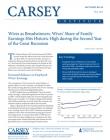
October 4, 2010
In the second year of the recession, wives' contributions to family earnings leapt again, jumping two percentage points from 45 percent in 2008 to 47 percent in 2009. This rise marks the largest single-year increase in 15 years. This is not due to an increase in their earnings but rather to a decrease in husband’s employment, as the economy disproportionately shed male-dominated jobs during…
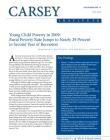
September 28, 2010
The U.S. Census Bureau's release of its American Community Survey data in September 2010 illustrated some expected changes in poverty rates in 2009, the second year of the Great Recession. For young children under age 6, living in poverty is especially difficult, given the long-term effects on health and education. Every region of the country except the West saw increases in rural young…
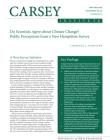
July 13, 2010
This report, a collaboration of the Carsey Institute, the UNH Survey Center, and the UNH Office of Sustainability, is the first of a new initiative that will track public perceptions about climate change as they change over time. Questions related to climate change were asked as part of New Hampshire's Granite State Poll, which surveyed 512 New Hampshire residents in April 2010.
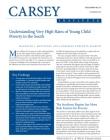
July 1, 2010
It is widely known that the South is home to some of the places with the highest rates of child poverty. To address the many challenges poor families face there, policy makers and community leaders need to understand the complex factors that converge in this region of the United States. This brief presents an analysis of national and state-by-state data to help readers understand high child…
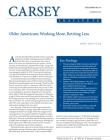
July 1, 2010
This Carsey brief finds that the percentage of Americans age 65 and older remaining in the labor force continues to grow steadily in urban, suburban, and rural areas. In 2009, 22 percent of older men and 13 percent of older women were still working compared to 17 percent of men and 9 percent of women in 1995. Moreover, increasing percentages of older workers hold full-time, full-year jobs.
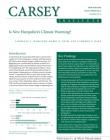
July 1, 2010
This Carsey brief looks at temperature anomalies across New Hampshire and shows that not only is the state warmer than it has been in the past, but it is also warming faster than much of the planet. Sociologist Lawrence Hamilton, research associate professor Cameron Wake, and former NH state climatologist Barry Keim analyzed over 100 years of temperatures across the state to produce this data for…
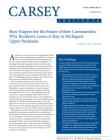
July 1, 2010
According to a Community and Environment in Rural America survey, Michigan's Upper Peninsula residents, often called "Yoopers," said that ties to community and the area's natural beauty were significant factors for those who planned on staying in this rural area, which comprises about a third of Michigan's land mass but only 4 percent of its population. Those planning on…
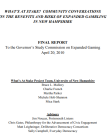
April 20, 2010
The two primary goals for the What’s At Stake project were to: gather broad citizen input to inform the policy question of whether or not to expand legalized gambling in NH (on behalf of the Governor‘s Commission) and demonstrate a different way of soliciting such input, beyond the traditional forms of public hearings and opinion polls (recognizing that both play an important role in the policy-…